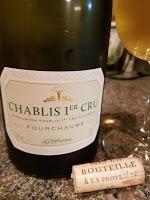 Like many Medieval towns, Chablis is built upon a waterway, the Serein River, which provides the distinct characteristics based on the river's banks. Vines are planted on the hills overlooking both banks, with the right side receiving the evening sun and the left bank the morning sun. This means the right bank receives more exposure - providing a little more flavor to the Chardonnay grapes. This was definitely true in past years but recently, with a warming climate, many vines on the left bank have been able to achieve full ripeness. During a Climats by Geography Twitter tasting sponsored by The Chablis Commission, Christy Canterbury MW presented these facts as well as the history of four wines we sampled.
Like many Medieval towns, Chablis is built upon a waterway, the Serein River, which provides the distinct characteristics based on the river's banks. Vines are planted on the hills overlooking both banks, with the right side receiving the evening sun and the left bank the morning sun. This means the right bank receives more exposure - providing a little more flavor to the Chardonnay grapes. This was definitely true in past years but recently, with a warming climate, many vines on the left bank have been able to achieve full ripeness. During a Climats by Geography Twitter tasting sponsored by The Chablis Commission, Christy Canterbury MW presented these facts as well as the history of four wines we sampled.The Chablis region maintains an Appellation D'Origine Controllee (AOC) system with four classifications: Petit Chablis, Chablis, Premier Cru, and Grand Cru. The first two are broader in nature; while the second two consist of specific climats - or micro-terroirs. Our wines were AOC Premier Cru which was created in 1938 and as of 2017 accounted for 14% of Chablis wines. There are 40 Chablis Climats that are Premier Cru with Climat defined as a delimited land parcel with special geological and climatic conditions.
Chablis is a cold grape-growing climate and as Canterbury describes "it is a very continental climate with brutal winters. April can be a stressful time for vignerons when they spend many nights warding away frost in the wines". Chablis is situated in northern Bourgogne, meaning that the region is located closer to Champagne than Côte de Nuits -- and one reason Chardonnay is the preferred grape. The cold climate also provides acidity which is a coveted characteristic of Chablis production.
The second shared character is that the soil is 150 million years old and the Kimmeridgian Limestone is loaded with fossilized oyster shells. This character noticeable amounts of minerals into the wine at times providing a wet stone sensation. And Canterbury noted that these "soils are so distinctive they were quarried to build St. Paul's Cathedral in London".
Right Bank Wines
 Chablis Premier Cru Mont de Milieu Drouhin Vaudon 2014
Chablis Premier Cru Mont de Milieu Drouhin Vaudon 2014This excellent wine is fresh and bright with a slight lemon character intertwined with wet stone and velvety texture. The grapes are grown on a historical 18th-century Drouhin Vaudon estate that consists of 38 hectares -- all under organic care. The name Mont de Milieu (middle mountain) was derived from the hill's former position between the County of Champagne and the Duchy of Bourgogne as documents describe Mont De Milieu as far back as the 13th century. The part of the region that faces the town of Chablis is a bit sunnier while the portion that faces the hamlet of Fleys, in the valley to the east, is cooler. And interestingly Mont de Milieu does not have any sub-Climats or further divisions within its borders -- unlike most Chablis Climats.

La Chablisienne 1er Cru Fourchaume La Chablisienne 2016
The wine is characterized by more wet stone mixed with peaches, creamy velvety texture, and a lingering finish. Fourchaume is a region that stretches onto a different hillside, attached to the northern edge of the Grand Cru vineyards. And a little history from Canterbury, the region was written Fourchaulme in 1540 and most likely comes from “fourche” or fork, referring to a fork in the road or the fork between Vaulorent and Cote de Fontenay. This La Chablisienne wine is vinified and aged in both fûts (barrels of 228 liters) & stainless steel for approximately one year. Canterbury noted that it has more “stuffing” to benefit from oak aging.
Left Bank Wines
 Chablis Premier Cru Montmain Louis Michel & Fils 2016
Chablis Premier Cru Montmain Louis Michel & Fils 2016 This wine provides tropical and lychee characters, is saline driven and completes with velvety depth and controlled acids. The Michel family has grown and produced Chablis since 1850. Guillaume Gicqueau-Michel oversees his family estate and one of his signatures is using only stainless steel to vinify and age his wine. According to Canterbury this allows for only the "purest essence of his terroirs". The family maintains two hectares in Montmains with two parcels in its center, near the Fôrets sub-appellation. Montmains is a large Chablis Climats that i sub-divided into two other two sub-Climats. Unlike Mont de Milieu, which has no shadows from the sun, Montmains vineyards do.
 Domaine Denis Race Chablis Premier Cru, Vaillons 2015
Domaine Denis Race Chablis Premier Cru, Vaillons 2015 This delicious wine has a citrus and peach base to the wet stone, solid acids and lingering tail. Domaine Denis Race is a 4th generation estate with the parcels between two and 65 years old. This wine has bigger fruit as the Vaillons is south-facing and known for its intense sunlight. Spelled Valion in 1429, this Chablis Climats overlooks a little valley or “vallon”. According to our host, this may have been corrupted to Vaillons by way of the old folk who used to call valleys “valsons”.
